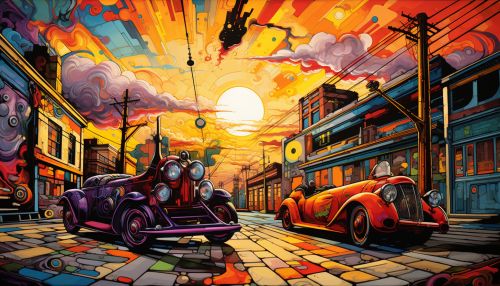Futurism
Overview
Futurism is a modernist, avant-garde art movement that originated in Italy in the early 20th century. It was largely an Italian phenomenon, though there were parallel movements in Russia, England, Belgium and elsewhere. The Futurists practiced in every medium of art, including painting, sculpture, ceramics, graphic design, industrial design, interior design, urban design, theatre, film, fashion, textiles, literature, music, architecture, and even gastronomy. The founder of Futurism and its most influential personality was the Italian writer Filippo Tommaso Marinetti. Marinetti launched the movement in his manifesto of 1909, which he published for the first time on 5 February of that year in La gazzetta dell'Emilia, an article then reproduced in the French daily newspaper Le Figaro on 20 February 1909.


History
The Futurists admired speed, technology, youth and violence, the car, the airplane and the industrial city, all that represented the technological triumph of humanity over nature, and they were passionate nationalists. They repudiated the cult of the past and all imitation, praised originality, "however daring, however violent", bore proudly "the smear of madness", dismissed art critics as useless, rebelled against harmony and good taste, swept away all the themes and subjects of all previous art, and gloried in science.
Publishing manifestos was a feature of Futurism, and the Futurists (usually led or prompted by Marinetti) wrote them on many topics, including painting, architecture, religion, clothing and cooking.
The founding manifesto did not contain a positive artistic programme, which the Futurists attempted to create in their subsequent Technical Manifesto of Futurist Painting (1910). This committed them to a "universal dynamism", which was to be directly represented in painting. Objects in reality were not separate from one another or from their surroundings: "The sixteen people around you in a rolling motor bus are in turn and at the same time one, ten four three; they are motionless and they change places... The motor bus rushes into the houses which it passes, and in their turn the houses throw themselves upon the motor bus and are blended with it."
Artistic techniques
The Futurist painters were slow to develop a distinctive style and subject matter. In 1910 and 1911 they used the techniques of divisionism, breaking light and color down into a field of stippled dots and stripes, which had been originally created by Giovanni Segantini and others. Later, Severini, who lived in Paris, attributed their backwardness in style and method at this time to their distance from Paris, the centre of avant-garde art.
Severini was the first to come into contact with Cubism and following a visit to Paris in 1911 the Futurist painters adopted the methods of the Cubists. Cubism offered them a means of analysing energy in paintings and expressing dynamism. They often painted modern urban scenes. Carrà's Funeral of the Anarchist Galli (1910–11) is a large canvas representing events that the artist had himself been involved in, in 1904. The action of a police attack and riot is rendered energetically with diagonals and broken planes. His Leaving the Theatre (1910–11) uses a Divisionist technique to render isolated and faceless figures trudging home at night under street lights.
Influence and legacy
The Futurism art movement was important in the evolution of 20th century art and continues to be studied and celebrated today. It has influenced many other movements, including Art Deco, Vorticism, Constructivism, Surrealism, Dada, and to a greater degree, Precisionism, Rayonism, and Dynamism. The ideals of Futurism remain as significant components of modern Western culture; the emphasis on youth, speed, power and technology finding expression in much of modern commercial cinema and culture. Ridley Scott consciously evoked the designs of Sant'Elia in Blade Runner. Echoes of Marinetti's thought, especially his "dreamt-of metallization of the human body", are still strongly prevalent in Japanese culture, and surface in manga/anime and the works of artists such as Shinya Tsukamoto, director of the Tetsuo (Iron Man) films.
